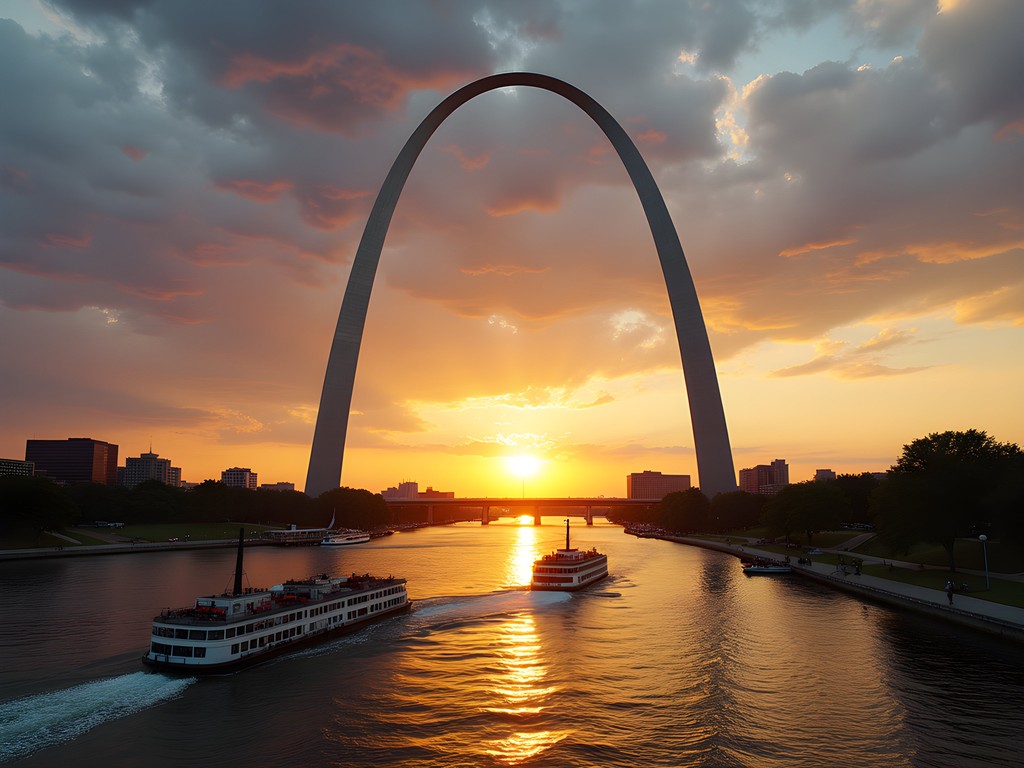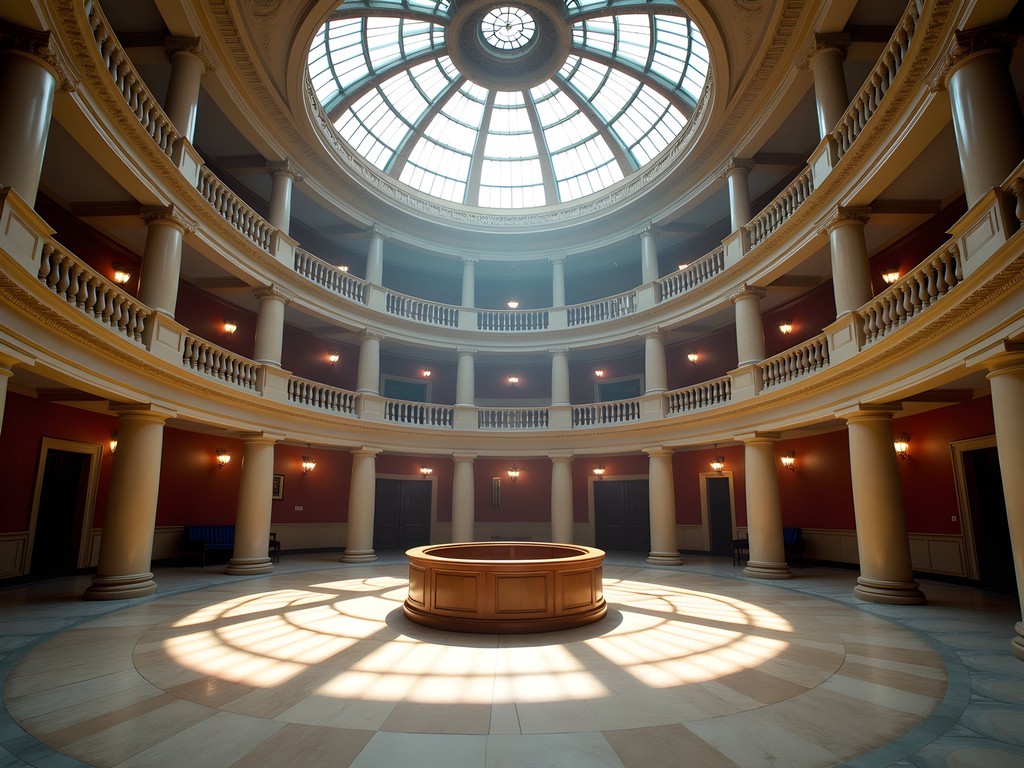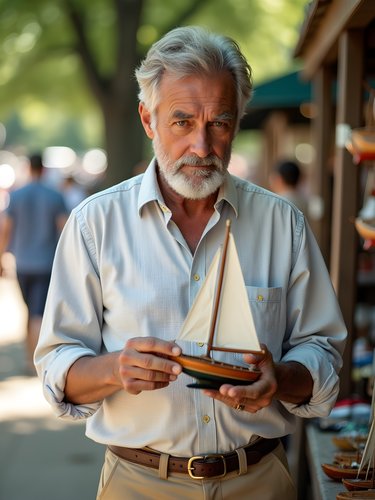Disclosure: This article contains affiliate links. We may earn a commission from purchases at no extra cost to you, which helps our travel content.
Standing at the helm of my European houseboat La Segunda Vida, I often find myself drifting into memories of America's great waterways. Before my life in Valencia and my floating podcast studio, I spent three decades studying the ecosystems of the Great Lakes. The mighty Mississippi River, that grand liquid highway that shaped America's westward expansion, has always held a special fascination for me. And no city embodies the river's historical significance quite like St. Louis—a place where water and land, past and present, east and west converge in magnificent harmony.
The Gateway Arch: America's Stainless Steel Sail
No landmark captures the spirit of St. Louis—or America's westward journey—quite like the Gateway Arch. At 630 feet tall, this gleaming monument rises from the riverfront like a massive stainless steel sail catching the winds of history.
As someone who's spent his life on water, I appreciate monuments that echo nautical themes, even unintentionally. The Arch's graceful curve reminds me of the elegant prow of a ship breaking through waves—appropriate for a city that served as the launching point for countless westward journeys.
The tram ride to the top provides views that would make any river captain envious. Looking east across the Mississippi, you can trace the river's path as it winds toward the Gulf of Mexico. To the west lies the vast expanse that called to pioneers and explorers. I recommend bringing a good pair of compact binoculars to fully appreciate the confluence of the Mississippi and Missouri rivers from this height—a meeting of waters that changed the course of American history.

💡 Pro Tips
- Purchase tram tickets online in advance to avoid long waits, especially during summer months
- Visit early morning or late afternoon for the best lighting conditions for photography
- The Museum at the Gateway Arch beneath the monument is free and worth exploring before or after your tram ride
The Old Courthouse: Where Ripples of Justice Began
Just a short walk from the Arch stands the Old Courthouse, where the waves of America's reckoning with slavery began to form. This is where enslaved Dred Scott and his wife Harriet first sued for their freedom in 1846, initiating a legal battle that would culminate in one of the Supreme Court's most infamous decisions.
The building itself is an architectural marvel with its cast-iron dome (modeled after St. Peter's Basilica) and rotunda featuring intricate murals. But it's the human stories that resonate most powerfully here. As I wandered through the restored courtrooms, I found myself thinking about how often history's most significant currents begin as small disturbances—a single person standing up and demanding justice.
The exhibits are thoughtfully curated and provide excellent context for families with children of various ages. I saw parents using the National Geographic Kids Everything Civil Rights Movement book to help younger visitors understand the significance of what happened here, bridging the gap between then and now in terms kids can grasp.

💡 Pro Tips
- Take time to watch the 20-minute film about the Dred Scott case
- Check the schedule for living history presentations which bring the courthouse proceedings to life
- The building offers excellent examples of 19th-century architecture—look for the ornate ironwork and restored period details
The Eads Bridge: Engineering Marvel of the Mississippi
As someone who's spent decades studying waterways and navigating various vessels, I hold a special appreciation for the Eads Bridge. Completed in 1874, it was the world's first steel truss bridge and the longest arch bridge on earth at that time. Engineer James Eads, who had previously designed riverboats and salvage vessels, understood the Mississippi's temperamental nature better than most.
The bridge's construction involved revolutionary techniques, including the use of pneumatic caissons that allowed workers (called "caisson men") to excavate the riverbed beneath the water's surface—similar in principle to how modern divers work in underwater habitats. Many suffered from "caisson disease" (what we now call decompression sickness), making this bridge a monument to human ingenuity and sacrifice.
Today, you can walk across its pedestrian pathway for spectacular views of the river and city skyline. I spent a contemplative afternoon here with my travel journal recording observations about river traffic and sketching the distinctive triple arches—a practice I've maintained since my marine biology days. For photography enthusiasts, the bridge provides excellent framing opportunities for capturing the Gateway Arch from unique angles.

💡 Pro Tips
- Walk the bridge near sunset for dramatic lighting on both the river and the Gateway Arch
- Look for the plaque explaining the revolutionary engineering techniques used in construction
- Bring a camera with a wide-angle lens to capture the full span of the bridge in relation to the city skyline
The Campbell House Museum: Victorian Life Preserved
After days spent exploring monuments to grand historical movements, I found the Campbell House Museum offered a delightful change of pace—an intimate glimpse into the daily life of St. Louis' wealthy merchant class during the Victorian era. This meticulously restored townhouse belonged to fur trader and entrepreneur Robert Campbell and his family from 1854 to 1938.
As someone who now lives aboard a vessel filled with carefully chosen possessions, I was fascinated by the Campbells' material world—the ornate furniture, elaborate textiles, and extensive collections that defined upper-class domestic life in the 19th century. The contrast between this opulent home and the spartan quarters aboard riverboats of the same era couldn't be more striking.
The museum offers excellent guided tours that bring the Campbell family's stories to life. I was particularly impressed by the preservation work—photographs from the early 20th century were used to ensure accurate placement of original furnishings. For families with children interested in history, I recommend picking up the Victorian House Coloring Book from the gift shop, which helps younger visitors appreciate architectural details they might otherwise overlook.

💡 Pro Tips
- Take the guided tour rather than self-guiding—the docents provide fascinating context about both the house and St. Louis society
- Photography is permitted without flash, making this a good spot for architecture and interior design enthusiasts
- Visit during the holiday season when the house is decorated as it would have been for a Victorian Christmas
Cahokia Mounds: Ancient Mississippi Culture
Just across the river in Illinois lies a site that predates St. Louis by nearly a millennium—the Cahokia Mounds State Historic Site. As someone who studies the relationship between waterways and human civilization, I find this ancient Native American city profoundly moving. At its peak around 1200 CE, Cahokia was the largest urban center north of Mexico, home to as many as 20,000 people who built massive earthen mounds for ceremonial, residential, and burial purposes.
The site's centerpiece, Monks Mound, rises 100 feet above the floodplain and covers 14 acres at its base. Standing atop it, looking toward the Mississippi River that facilitated Cahokian trade networks, I felt the same sense of awe I experience when navigating Europe's ancient waterways—the recognition that water has always connected us, always sustained our civilizations.
For families, Cahokia offers an excellent opportunity to discuss indigenous history and engineering achievements. The interpretive center provides context through artifacts, dioramas, and a short film. I recommend bringing a field guide to help identify the various cultural elements and architectural features. Walking the grounds, children can burn energy while adults contemplate the sophisticated society that thrived here long before European contact.

💡 Pro Tips
- Start at the interpretive center to understand the site's significance before exploring the mounds
- Wear comfortable hiking shoes as the site covers 2,200 acres with significant walking between mounds
- Bring binoculars to spot wildlife in the reconstructed prairie areas—the ecosystem that would have surrounded ancient Cahokia
The Missouri History Museum: Currents of Time
Situated in beautiful Forest Park, the Missouri History Museum serves as an excellent anchor point for understanding St. Louis' complex historical currents. The museum's permanent exhibits trace the city's evolution from French trading post to bustling riverboat hub to modern metropolis.
I was particularly drawn to the exhibits on river commerce and transportation—subjects close to my heart as both a former marine biologist and current houseboat dweller. The 1904 World's Fair exhibit also captivated me, showcasing how St. Louis once positioned itself as a global city at the threshold of the 20th century.
For families with children, the museum offers excellent interactive elements that make history tangible. I observed parents using the interactive history journal available in the museum shop to guide their children through exhibits with age-appropriate scavenger hunts and reflection questions. The museum's approach reminded me of how I structure my podcast episodes—weaving together artifacts, personal stories, and broader historical contexts to create meaningful narratives.
Don't miss the excellent temporary exhibitions, which often explore overlooked aspects of regional history. During my visit, a compelling exhibit examined the environmental history of the Mississippi watershed—a subject that bridged my past career with my current interests in cultural preservation and sustainable tourism.

💡 Pro Tips
- Allow at least 2-3 hours to properly explore the permanent collections
- Check the schedule for family-friendly weekend workshops and demonstrations
- The museum's cafe offers good lunch options if you need to refuel during your visit
Soldiers Memorial Military Museum: Honoring Sacrifice
My father served in the Navy during the Korean War, so military museums always hold personal significance for me. The recently renovated Soldiers Memorial Military Museum offers a thoughtful, comprehensive look at American military history through the lens of St. Louis and Missouri.
The memorial building itself, with its art deco design and limestone façade, was dedicated by President Franklin D. Roosevelt in 1936. Inside, exhibits trace the region's military connections from the American Revolution through modern conflicts. The Court of Honor outside provides a contemplative space to reflect on sacrifice and service.
What impressed me most was how the museum contextualizes war within broader social and political currents—showing how conflicts shaped and were shaped by American society. For families navigating difficult conversations about war with children, I recommend the children's guide available in the museum store, which presents history in an age-appropriate but honest manner.
As someone who's navigated many of the world's waterways, I found myself drawn to exhibits on riverine warfare and naval contributions from the region. The Mississippi River's strategic importance during the Civil War receives particular attention, highlighting how control of waterways often determines historical outcomes—a theme that resonates throughout St. Louis' story.

💡 Pro Tips
- Visit the outdoor Court of Honor early morning or evening for a more contemplative experience
- Look for the interactive oral history stations where you can listen to veterans' firsthand accounts
- Check the calendar for special commemorative events around Memorial Day and Veterans Day
Final Thoughts
As I prepare to return to my floating home in Valencia, I find myself reflecting on how St. Louis embodies America's relationship with its waterways. From the indigenous city of Cahokia to the steamboat era to today's working river port, the Mississippi has been the constant current connecting disparate chapters of history.
What makes St. Louis especially rewarding for families is how its landmarks make abstract historical concepts tangible. Children can touch the base of the Gateway Arch, climb the ancient stairs of Monks Mound, or examine a riverboat model while parents connect these experiences to broader historical narratives.
Perhaps that's the greatest gift of historical travel—the way it allows us to momentarily step into the current of time, to feel how the past flows into present. In St. Louis, that current is as wide and powerful as the Mississippi itself, carrying stories of ambition and struggle, innovation and sacrifice, promise and contradiction.
For my next episode of 'The Floating World,' I'll be exploring how river cities like St. Louis compare to the canal towns of Europe—how different cultures have built their identities around the waterways that sustain them. Until then, I encourage you to chart your own course through history, whether on the mighty Mississippi or the gentle canals of your own journey.
✨ Key Takeaways
- St. Louis offers accessible historical sites perfect for multi-generational family exploration
- The Mississippi River's influence connects many of the city's most significant landmarks
- Plan at least a full weekend to properly experience the seven essential historical sites
- Many sites offer specific family programming and materials to engage younger visitors
📋 Practical Information
Best Time to Visit
Spring (April-May) and Fall (September-October) offer mild temperatures ideal for walking between sites
Budget Estimate
$500-700 for a weekend family trip including mid-range accommodations, admissions, and meals
Recommended Duration
2-3 days minimum to properly experience all seven landmarks
Difficulty Level
Easy - Most Sites Are Accessible And Suitable For All Ages And Mobility Levels











Comments
Fatima Sims
Michael, your post brought back so many memories! I visited St. Louis last spring and was completely captivated by the Campbell House Museum - what a hidden gem! The guide shared fascinating stories about the family's daily life that you just don't get from reading placards. One tip for anyone heading there: the Metro Link public transit system is surprisingly efficient for getting between these landmarks. I bought a day pass and hit most of these spots without needing a car or dealing with parking. I also recommend bringing a good camera with a wide-angle lens for the Arch - my smartphone just couldn't capture the full majesty. I used my travel tripod for some amazing night shots of the illuminated Arch. Michael, does your houseboat podcast ever cover American river towns? Would love to hear that perspective!
Michael Dixon
Thanks Fatima! Great point about the Metro Link - I should have mentioned that in the post. And yes, I'm actually planning a series on American river towns for the podcast this winter! St. Louis will definitely be featured. I'll announce it on the blog when it's ready.
escaperider
Love your writing style! The comparison between European waterways and the Mississippi was beautiful.
exploreadventurer
Did you take one of those Mississippi River cruises while you were there? Wondering if they're worth the money or just tourist traps.
Fatima Sims
Not Michael, but I did a sunset cruise on my St. Louis trip last year! Definitely worth it - the perspective of the city from the water is incredible, especially seeing the Arch from below. I took the 2-hour history cruise on the replica paddlewheel boat and learned so much about the river's role in the city's development. Bring a light jacket though - it gets breezy on deck!
exploreadventurer
That sounds amazing! Adding it to my list. Thanks for the jacket tip too!
travelzone
Just visited the Old Courthouse last weekend. The Dred Scott exhibit was so powerful!
cooldiver
Great post, Michael! I'm planning a trip to St. Louis this fall. Is there a specific time of day that's best for visiting the Gateway Arch? I've heard sunset views are amazing but tickets sell out fast.
Michael Dixon
Thanks for reading! You're right about sunset tickets - they go quickly. I'd recommend booking at least 2-3 weeks in advance for those golden hour rides. If that's not possible, early morning (9-10am) tends to have shorter lines and beautiful light for photos.
cooldiver
Perfect, thanks for the tip! Will definitely book ahead.
WanderlustFamily
If you're visiting the Arch, go early! The lines get crazy by midday, especially in summer. We got there right when it opened and walked right in.
greenzone
Born and raised in St. Louis, so it's always interesting to see my hometown through visitors' eyes. Michael, you captured the historical significance beautifully. For anyone visiting, I'd add the Scott Joplin House to your historical tour - it's small but provides amazing context about ragtime music and Black culture in early 20th century St. Louis. Also, the Missouri Botanical Garden dates back to 1859 and has incredible Victorian structures. My grandmother used to tell stories about the 1904 World's Fair that transformed Forest Park - wish some of those grand buildings had survived!
luckyseeker
Thanks for the local perspective! Is the Botanical Garden worth visiting in winter or better to wait for spring?
greenzone
The Climatron (their geodesic dome greenhouse) is amazing year-round! But if you can wait for spring, the Japanese Garden is at its best then.
HistoryBuff1983
Great post! Is the Campbell House Museum accessible for someone with mobility issues? My mom uses a walker but loves Victorian history.
STLnative
The Campbell House has some accessibility challenges since it's a historic building. The first floor is accessible but the upper floors aren't. They do offer a virtual tour of the upstairs though!
Hunter Thompson
Mate, this post brought back so many memories! I backpacked through the Midwest last summer and spent three days in St. Louis. The free museums in Forest Park are an absolute bargain - spent hours in the Art Museum and History Museum without spending a penny! For fellow backpackers: the MetroLink from the airport to downtown is dead easy and way cheaper than a taxi. Also found a brilliant free walking tour that covers the Old Courthouse and Eads Bridge - just tip what you can afford. Michael - curious about your houseboat podcast studio! Sounds like the dream setup.
wanderluststar
Love your sunset shot of the Arch! What camera settings did you use?
Venture X
Premium card with 2X miles, $300 travel credit, Priority Pass